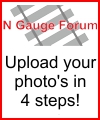- Welcome to N Gauge Forum.
need some info on gas welding pleaseStarted by guest311, March 10, 2022, 12:37:41 PM Previous topic - Next topic0 Members and 1 Guest are viewing this topic.
User actions
| Please Support Us!
December Goal:
£120.00 Due Date: Dec 31 Total Receipts: £34.56 Below Goal: £85.44 Site Currency: GBP 29% December Donations |





